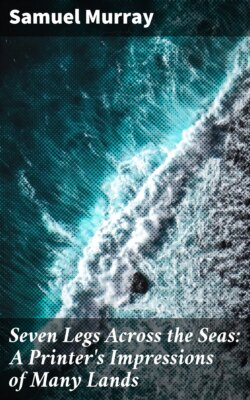Читать книгу Seven Legs Across the Seas: A Printer's Impressions of Many Lands - Samuel Murray - Страница 7
На сайте Литреса книга снята с продажи.
ОглавлениеSouthern Cross.
"Neptune" is a "game" played only at sea, and the "sport" is generally indulged in when a passenger steamship is sailing under the equator. A canvas tank is fixed on deck and nearly filled with water. It is an unvarying rule with some travelers that one who has not crossed the equator must be "Neptuned." A "coaster," as one is termed who has never crossed the equatorial line, is reminded by the Simon-pures that, in order to be a full-fledged traveler, he must take a plunge in the canvas tank. Most passengers who are not sick comply with the request, but there are some who do not take kindly to the idea. In such instances a half dozen, or a dozen passengers if necessary, bend the will of the unwilling one to their idea of maintaining this tradition of the sea by literally picking up the unbeliever and pitching him into the canvas tank of water. He then has been "Neptuned." Danger of taking cold from this outdoor plunge is slight, as often the tar in the cracks between boards on deck of the ship is bubbling from the intense rays of the sun.
Having reached the southern division of the world, the heavenly bodies forming the Southern Cross appear. The cross is not composed of a thickly starred upright beam, neither is there a compact panel of stars forming the crosspiece. Four stars located at certain sections of the heavens form a distinct outline of a cross. The great crucifix at times appears to be standing straight, but more often it will be seen in the heavens in a reclining position, so to speak; again it will be observed resting on its side, but never pointing downward. The section of the sky in which the cross is to be found is the southeast. At one season of the year it will rest near the center of the firmament and in the "Milky Way "; at another period it will be seen closer to the horizon. Lesser bodies appear in the zone embraced by the four stars that compose the profile of the ensign of Christianity, but these neither add to nor detract from the formation of the solemn emblem of suffering that stands out so clearly among the millions of orbs in the starry firmament. Two bright stars below, in direct line with the bottom star of the cross, are called "the pointers."
What a difference is at once apparent in the period of daylight north of the equator and that south of the equatorial line. From a slow setting sun and a lingering twilight north of the great line to a rapidly setting sun and a comparatively short twilight south of the equator is observed. Fifteen to twenty minutes after the sun sets darkness will have settled.
"Holy stoning a ship" is a nautical term that, when first heard by a landsman, arouses his curiosity concerning the particular duty the phrase suggests in a sailor's routine. A holy stone—somewhat larger than two bricks placed together, of cream color and of a soft or sandy material—is used to whiten the deck of a ship. Most persons would conclude that a thorough washing of a deck with clear water should satisfy one possessed of even super-neat exactions. But a sailor's conception of the term "spick and span" does not end in this matter with the merit of water alone. The holy stone is secured in an iron frame similar to that of a house mop, with handle attached. It is also pushed forward and pulled backward when used to clean a deck in the same way that a mop is used to clean a floor. The deck is made wet before "stoning," then sprinkled with fine white sand, and is next thoroughly gone over with the "cleaner." When the sailor has finished his hard "scrubbing" task the deck appears many shades brighter than it would if only water had been used. The term "holy stone" is said to have originated through the first stones used in bleaching ship decks having been taken from the ruined walls of a church in Cornwall, England.
